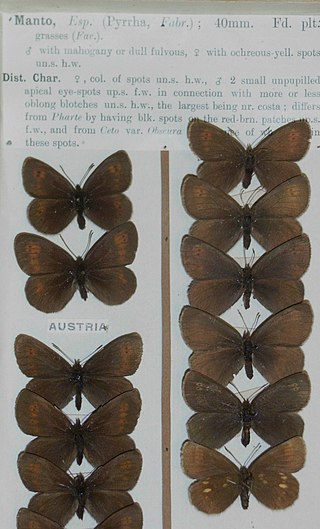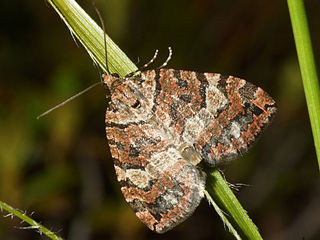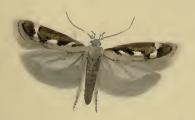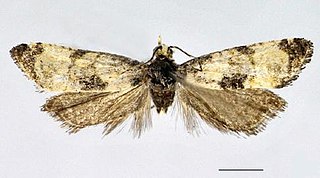
Cerapteryx graminis, the antler moth, is a moth of the family Noctuidae. It is a common species throughout most of Europe but is lacking in the very dry southern regions. The northernmost occurrence is Iceland, and above the Arctic circle. It also occurs in Siberia and in North Mongolia. The species has been introduced to North America. In the Alps it rises to an altitude of 2100 meters.

The shoulder-striped wainscot is a moth of the family Noctuidae. The species was first described by Carl Linnaeus in 1761. Some authors place it in the genus Mythimna. It is found throughout Europe and in Russia to the west of the Urals.

Apatura ilia, the lesser purple emperor, is a species of butterfly native to most of Europe and east across the Palearctic. It is named for its similarity to the purple emperor butterfly.

The yellow-spotted ringlet is a member of the subfamily Satyrinae of the family Nymphalidae. It is associated with (sub)alpine meadows at 900–2,500 m above sea level. It is found in the Alps, the Pyrenees, the Cantabrian Mountains, the Massif Central, the Vosges Mountains, the Carpathian Mountains and the mountains of Herzegovina.

Agriphila selasella is a species of moth of the family Crambidae. It was described by Jacob Hübner in 1813 and is found in Europe and east across the Palearctic.

Pyrausta purpuralis is a species of moth of the family Crambidae. It was described by Carl Linnaeus in his 1758 10th edition of Systema Naturae

Dasystoma salicella, sometimes also known as the blueberry leafroller, is a moth of the family Lypusidae. It is endemic to Europe, but is an introduced species in North America.

Hydriomena furcata, the July highflyer, is a moth of the family Geometridae. The species was first described by Carl Peter Thunberg in 1784. It is found in the Holarctic ecozone.

Erebia pandrose, the dewy ringlet, is a member of the subfamily Satyrinae of the family Nymphalidae. It is found from the Arctic areas of northern Europe, the Pyrenees, Alps, the Apennine Mountains, the Carpathian Mountains, Kola Peninsula and Kanin Peninsula, part of the Ural and the Altai and Sayan Mountains up to Mongolia.

Lobesia littoralis is a moth of the family Tortricidae. It is distributed wherever the foodplant occurs around the coasts of Europe, including the Faroes, Iceland and St Kilda.

Gypsonoma aceriana, the poplar shoot-borer, is a moth of the family Tortricidae. It is found from Europe to Russia, eastern Turkey and Iraq. It is also present in North Africa.

Erebia melampus, the lesser mountain ringlet, is a member of the subfamily Satyrinae of the family Nymphalidae.

Cochylis hybridella is a moth species of the family Tortricidae. It is found in most of Europe, the Near East, China, Japan, Korea and Russia.

Caryocolum marmorea is a moth of the family Gelechiidae. It is found from Scandinavia to the Mediterranean islands, and from Ireland to Poland, Hungary and Greece. It is also found on the Canary Islands and Madeira. It is also found in North America.

Polymixis lichenea, the feathered ranunculus, is a moth of the family Noctuidae. It is found in western Europe and Morocco. It is mainly found in coastal areas.

Holocacista salutans is a moth of the family Heliozelidae. It was described by Edward Meyrick in 1921. It is found in Zimbabwe and the South African provinces of KwaZulu-Natal and Limpopo.

Arethusana is a butterfly genus from the subfamily Satyrinae of the brush-footed butterfly family (Nymphalidae). It is composed of only one species, Arethusana arethusa, the false grayling.

Cochylichroa atricapitana, the black-headed conch, is a moth of the family Tortricidae. It is found in China (Xinjiang) and the eastern Palearctic and most of Europe.

Cochylis dubitana, the little conch, is a moth of the family Tortricidae. It is found in China (Heilongjiang) and most of Europe. and the Caucasus. It is also found in North America, where it has been recorded from Colorado, Maine, Ontario and Washington.

Cnephasia conspersana is a species of moth of the family Tortricidae. It is found in Ireland, Great Britain, France, Italy, Portugal, Spain and North Africa. The habitat consists of coastal chalk downlands and heathlands.



















